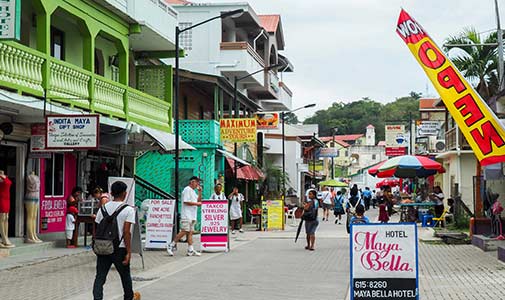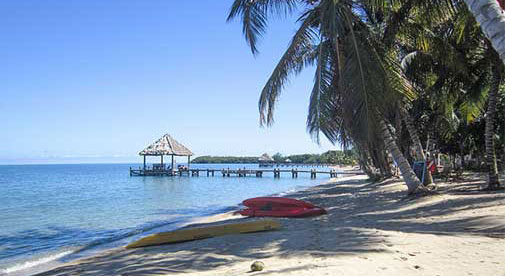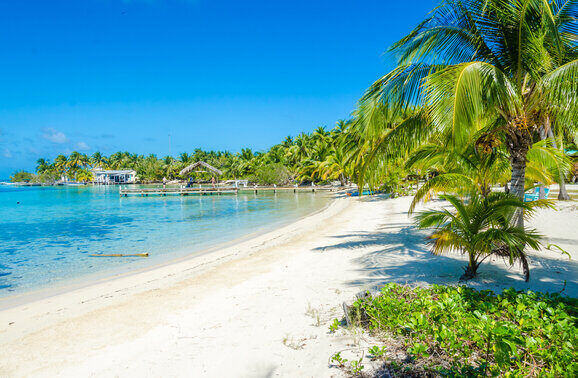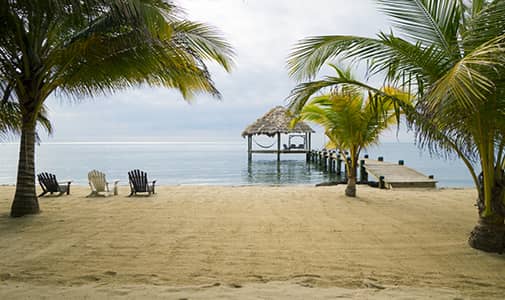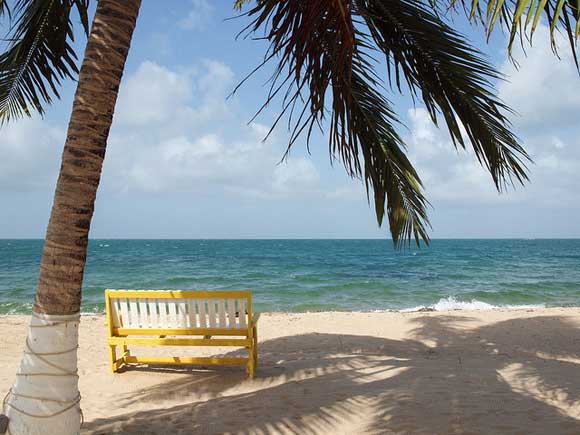Cayo, Belize
Written by Kacie Crisp
Cayo, in Western Belize, is a quiet, laidback, and affordable alternative to the more busy areas of Ambergris Caye or Placencia. This inland region is both the name of one of Belize’s six districts and the locals’ name for its largest metropolis, the twin cities of San Ignacio and Santa Elena.
It backs up to the jungle-covered Maya Mountains, and is traversed by three rivers—the Mopan, the Macal, and the Belize River where the Mopan and Macal come together just outside the small town of Bullet Tree Falls. Other areas of Cayo, such as Spanish Lookout, resemble Ohio with palm trees, where the industrious Mennonite population has cleared the rolling hills and planted it with corn, beans, and orange groves.
Of the 4 R’s that characterize Belize—reefs, rivers, ruins, and rainforest—Cayo lacks only the reefs. The area is dotted with Maya ruins, some of them quite accessible. Herbal medicine trails can be found at many resorts, showcasing the bounty of the rainforest. Other resorts offer that commodity so often lacking in the modern world—genuine peace and quiet, often with stunning river views.
The Cayo District is home to 90,000 people—roughly one quarter of the country’s population. In many ways it’s the commercial center of the country, as the Mennonites of Spanish Lookout are major supplies of goods familiar to westerners—everything from vehicles of all kinds to hardware to building supplies. The country’s second largest grocery store—one of only three vaguely resembling an American supermarket—is also located there. Several new quasi-American supermarkets have just opened in Cayo.
The twin towns of San Ignacio and Santa Elena—joined by the Hawksworth Bridge across the Belize River—are the second largest town in the country, home to about 20,000 people. San Ignacio is home to banks, the country’s largest farmers’ market on Saturdays, as well as government agencies like The social Security Administration and the DMV.
There’s a sizeable expat community who are friendly but also self-sufficient. It’s ideal for those still working part-time online or via intermittent commuting to the U.S. or elsewhere, as it’s one of the closest expat hotspots to the country’s one international airport outside Belize City.
Retiring in Cayo

The immigration aspect of retirement in Belize can be simple and laidback, though it can require some patience to navigate the bureaucracy.
The easiest way is to arrive and get your automatic tourist visa, which is good for 30 days. It’s renewable indefinitely, for $50 BZ for the first six months and $100 BZ ($50 U.S.) forever after. Renewal used to be a daylong ordeal in Belmopan, the undistinguished capital of Belize. Happily, for Cayo residents, it can now be done at the Guatemalan border at Benque, just up the road from San Ignacio and Santa Elena, for periods of two or three additional months at one time.
After staying in the country for 50 out of 52 weeks (they are extremely strict and literal about this) with your tourist visa, you can then apply for permanent residency, which can take months to sometimes a year or two.
The famous QRP (Qualified Retired Persons) visa has been depreciating in value markedly. While you used to be able to own a business and at least oversee it, QRP now prohibits any business activity whatsoever.
The latest status being encouraged by immigration officials is temporary residency, for which either physical presence or a $500,000 investment in Belize qualifies you. It’s a rare expat house that does not meet the $250,000 U.S. investment requirement. This very new category is in the process of having its administrative bugs worked out.
One draw of the QRP program is that it allows you to bring your household goods in during your first year in the country. I have recently heard that attaining permanent residency allows you the same privilege, without having to deal with the QRP-mandated challenge of opening a Belizean bank account.
There is a variety of housing available, but it’s all houses, no condos or apartment complexes to speak of, though you may find the odd second unit. Houses can be found in town, as well as in the surrounding countryside. The countryside homes often include enough land to grow whatever you fancy, and are clustered around the rivers and on hillsides overlooking town.
Housing prices, whether rental or sale, are always quoted in U.S. dollars. You can buy an off-the-grid small (400 sq. ft.) cottage in an expat development seven miles out of town for $115,000, or you could build whatever you choose for roughly $250,000 for a roughly 1000 sq. ft. house. Houses in San Ignacio and its surroundings rent for prices from $500 up, while you can find a house in a village like San Antonio for $700 U.S.
Lifestyle in Cayo

One writer has characterized expats to Belize as quirky. If that’s so, then those residing in Cayo, sometimes referred to as the wild, wild west, are the quirkiest of the bunch. There’s a sizeable expat community, but those who do best are those who can create their own entertainment.
Wednesday afternoon darts at Remo’s Bar in Bullet Tree is the don’t miss expat activity for those who can’t live without socializing with their own kind. Other social activities do exist—mostly for those who create them. Residents in my development have made a tradition of Saturday evening dinners at the restaurant in the small town of Santa Familia, as well as having sporadic get-togethers at local houses.
For those interested in more active pursuits, horseback riding, river tubing, canoeing, kayaking, hiking, swimming in resort pools, and exploring Mayan ruins beckon.
While there are several good local restaurants in addition to snack bars in the market and around downtown serving mainly Belizean cuisine, Cayo is better for those inclined to take advantage of the organic food available here, or even grow their own. The land and the climate are so verdant you can stick just about anything in the ground and it will grow. Many expats have avocado, citrus, soursop, mango, banana, and other trees in their yards. The prospect of growing their own food is quite a draw for many expats.
If you long for an escape from the higgledy-piggledy architecture of this truly typically Central American region, elegant upscale resorts are happy to entertain you, offering an instant escape into a North American aesthetic complete with gourmet cuisine, sparkling swimming pools, and fully equipped bars with all the tropical drinks you know and love.
Cost of Living in Cayo

Affordability is a big draw in Cayo. Whereas beachfront lots in Placencia start at $250,000, we bought our riverfront lot for less than $35,000. We paid a premium for being in an expat development (not a gated one), but we considered that worth it for the benefits of having experienced neighbors around who could answer questions about where to find things in the always intriguing treasure hunt that is Belize.
You can rent a two-bedroom house in town or on the outskirts from $500 per month, or you could rent a cottage in our development from $750 for a long-term rental. A spacious, completely North American standard, all solar house in our development rents for $850 per month. Despite the abundance of for sale signs, the real estate business is not well-developed here, so finding a long-term rental may be easier to do if you started with an Airbnb or VRBO rental to use as a base while you asked around to find something that suited you.
Food is also more affordable in the Cayo than in the beach towns. The fertile ground and open space of Cayo mean everyone grows some kind of food, which they offer in the market at great prices. We spend about $40 a week on dairy products (yogurt, cream for my husband’s coffee, butter, ricotta cheese) and another $20 of that on vegetables and fruit, many of which we buy organically. We usually indulge in buying two chicken quarters each from the barbecue stands along the road in Santa Elena, and this sets us back $10 for all four. As in the islands, American brands like potato chips and corn flakes have to be imported, so their cost is roughly double what you would pay at home. Even some specialty items like gluten free flours, for example, can be found here, again at prices twice what you would pay in the U.S.
Whereas island restaurants are aimed at the tourist market with North American prices, many restaurants here cater to locals with local’s only prices. You can fill up with breakfast in the market for $5, or splurge on breakfast in the local diner, huevos rancheros to die for with bacon and fresh orange juice, for $10.
Several upscale restaurants invite you to indulge right in San Ignacio—one of these is called Crave on West St., and the other is Guava Limb, owned and catered by the owners of Chaa Creek, the country’s premiere jungle lodge resort. Prices here approach North American prices, and you can definitely expect to pay North American prices if you indulge in a meal at one of the local jungle lodges that abound in Cayo.
The longer you live here, the more ways you find to survive comfortably and cheaply. You might start out buying your Belikin beer at the local Chinese (Belizean for grocery store) at $4 each, but eventually you learn that you can buy it so much cheaper by the case at the warehouse on the edge of Santa Elena.
With a total population of 350,000 in all of Belize, the country does not have the demand or population to support large or reliable inventory of items we take for granted in the U.S. You soon learn where to find items, which are usually in places a North American would not predict. A locksmith and make-up for sale at a gas station? A health food distributor in a singlewide trailer tucked behind a grain silo? Local wine for sale at the Shell gasoline dealer? Who knew?
Here’s an average monthly budget for a couple living in the Cayo, Belize:
| Expense | U.S. $ |
| Rent (two-bedroom home) | $700 |
| Utilities (including air conditioning) | $250 |
| Cell phones (x2) | $20 |
| Groceries | $300 |
| Streaming service and internet | $30 |
| Car (gas and maintenance) | $230 |
| Dining out | $200 |
| Total | 1,730 |
Where to Live in Cayo
Every kind of living accommodation you could ask for, other than ocean beachfront, is available in Cayo. You can either live right in town, in San Ignacio/Santa Elena, for maximum interaction with Belizean city life and walkability, or you could live in a quieter village, such as San Antonio or Cristo Rey, and enjoy the peace and soporific pace of Belizean village life. You can find luxurious, expat built homes with a pool and views from the hills for thousands of dollars per month or you can find a simple house for $500 to $700 for a year round rental.
If you live outside of San Ignacio or Santa Elena, you will most likely have to come to town for food and other supplies, since the small local stores have limited offerings. In the town near me, Santa Familia, real butter and tonic water are impossible to find, though Blue Bonnet margarine and Coke and Fanta are ubiquitous. Trips to town would require either a car or a taxi, which you should take into account.
There is a community of stunning natural wooden houses outside of the border town of Benque, Better in Belize, which is reachable only by 10 miles of dirt road. If a hermit’s life surrounded by stunning beauty is what you’re looking for, it might work for you.
5 Great Reasons to Move to Cayo, Belize
1. A Climate That Allows Indoor/Outdoor Living
The typical Belizean’s house is quite basic, but there’s a good reason for that. Most living occurs outside, in the shade. (That’s even the motto on the national flag, “In Shade, We Prosper.”)
The average temperature is 80 F year round and 24 hours a day. When the temperature drops below 70 F, we bring out the quilts to sleep. With ceiling fans, we never require air conditioning at night, and the fans are sufficient (with some regular river dips) to keep us comfortable all day, most days.
Our house, while completely screened, is not even completely enclosed, and is built to maximize the breezes that usually prevail from the east.
2. Living is Affordable
Especially if you own your home, there just isn’t that much to spend your money on in Belize, nor is there the temptation to keep up with the Joneses or have the latest greatest anything.
QRP (Qualified Retired Persons) visas require you to spend $2,000 a month in Belize. While we spend that if you count trips back to the U.S., Medicare, and our U.S. cellphone service, I would be hard-pressed to spend that much in Belize. Days slip by; our weekly dinner at the local restaurant with our neighbors doesn’t even cost us $50 for both of us, including beer for my husband.
3. English is the Official Language
When I’m in a Spanish speaking country as a non-Spanish speaker, I feel like I should apologize to service providers and others I interact with. With English as the official language, it is expected from all government offices, official forms, including immigration into the country. It may take a while to get the hang of some Belizean accents, but that’s part of the adventure. If I get a native Creole speaker at a government office, I call back another day and hope for someone (probably a woman, curiously enough) who speaks English I can understand.
Although the local workers my husband hired while building our house spoke Spanish at home, their Belizean school English was better than the English spoked by the Latinos he hired in California.
4. There’s a Sizeable Expat Community.
Keeping statistics on something like this is not a Belizean specialty, but one source estimates there are more than 1,000 expats in Cayo alone. One place to meet them is at Remo’s bar on Wednesday afternoon for darts, and you’re sure to run into plenty of them at Saturday’s market.
5. A Simpler, Quieter, More Relaxing way of Life.
No one hurries in Belize. It’s hot. If it doesn’t happen this week, it may happen next week or next month. In the meantime, the living is easy, the fruits and rum are plentiful, the breeze is blowing and most of the time the sun is shining. Isn’t that what you’re looking for?
Things to do in Cayo, Belize
1. The Saturday Market in San Ignacio

The country’s largest market swells on Saturdays, with Friday a close, less crowded second. In addition to the wealth of fresh produce in season, colorful hand-woven fabrics and hammocks, traditional carved slate designs, and baskets are available, as well as Belizean wine and traditional foods from Belize and beyond in Central America. You can find local groups playing music, as well as a local pastor ready to save your soul in espanol.
While you’re there, you can sample probably the cheapest breakfast or lunch in town, prepared while you wait from tarp-covered market stalls. The more upscale eateries, where breakfast might cost all of $5 for a breakfast burrito that will carry you through until dinner, are located at the back of the market, overlooking the Belize River.
An array of fresh juices are also available—everything from orange, lime, and watermelon to soursop, tamarind, and sorrel (a Belizean favorite made from a close relative of the hibiscus plant).
You can sample handmade mozzarella and ricotta cheese from the Mennonites whose stall is under the market’s largest tree.
2. Xunantunich Ruins

On the road towards the border town of Benque, Xunantunich offers many of the features of a Maya ruin, combined with easy accessibility. You can take your car or taxi on the hand-cranked ferry across the Mopan River and park near the entrance, or you could come by horseback tour from San Ignacio.
Climbing the pyramid, El Castillo, at 130 feet the highest structure among the ruins, yields a panorama of the amazingly uniform rainforest of Belize and Guatemala surrounding it. The sight and sound of varied species of monkeys and birds flitting through the trees are hard to miss. On the summit of El Castillo are large relief carvings representing astrological symbols, the sun god, moon, and Venus.
Six different groups of ruins, in various states of discovery and repair, comprise the site, which is at least 1,200 years old and rated one of the top 10 archeological sites in Belize. A visitors’ center on site tells the story of Xunantunich with a model of the site, photos, maps, and illustrations of significant events in the history of the city.
If archeological mystery appeals to you, this site has a long history. Legend has it that more than 100 years ago, a gentleman from the neighboring village of San Jose Succotz was hunting near the site when he encountered a statuesque Maya maiden in traditional attire. (Xunantunich means “stone maiden” in the local Mayan language.)
The hunter threw his gun down and went running back to the village. The village priest and some villagers returned, looking for the maiden. They succeeded in finding the doorway to the cavern the maiden had been standing in front of, but the woman herself had disappeared. Since then, she has appeared to several other visitors, but none has been able to follow her into the cavern. Might she be waiting for you?
3. Cave Tubing

Easily purchased from tour operators on Burns Avenue in San Ignacio, the cave tubing site is actually located just beyond the capital of Belmopan. Cave tubing is a uniquely Belizean activity, made possible by the caves created when rainwater flows through the limestone soil. Getting to the put-in point on the river takes a bit of a hike, during which your guide will educate you about the Belizean plants. His matter-of-fact tone will testify to the credence given to natural herbal remedies by Belizeans to this day.
After your educational hike, you place your tube in the river, plop yourself in the tube, and float on the river downstream. Your headlamp creates light and shadow on the eerie stalagmite and stalactite formations until you emerge into daylight at the other end of the cave.
Thrill seekers who wish to add zip lining to their excursion can easily do so, provided you leave early enough in the day to include both activities.
4. Green Iguana Conservation Project

Who knew that a bizarre looking green reptile, whose ancestors walked the earth 10.5 million years ago, would become the number 1 tourist attraction in San Ignacio? It’s true, the green iguanas entertain visitors hourly in a small purpose built shed on the grounds of the San Ignacio Resort Hotel. This species, on the endangered list, is fighting its way back from probable extinction with the help of this project. Some 40 iguanas are now being housed there, having been rescued from danger in the wild—either injuries in a fight with a predator or other iguana, or mere exposure as small round leathery egg abandoned by its mother right after she expelled it, two months before it would hatch and function on its own.
As is true for most animals, the more you learn, the more incredible and fascinating they become. Iguanas have not two but three eyes, the third one being in the center of their forehead like the human third eye. The iguana third eye, while not fully sighted, registers light and dark, alerting the animals to movement by hawks or other predators.
Like other lizards, they can regrow their tails if one is captured in a fight with a would-be predator. The stripes from the original tail do not return, however; if the tail is broken where it’s black, the replacement tail is all black. If the tail is broken in a green spot, the new tail will be all green.
This tour allows you to see these shy animals up close, as well as stroke their skin, which one tourist compared to very tightly done beadwork. It’s better to do this tour on a hot day, as these cold-blooded creatures slow down perceptibly on the rare cool days.
Note: The attractions listed above are easily accessible from San Ignacio. The attractions listed below require some travel on unpaved roads, which in Belize tend to be rocky and full of potholes. You can arrange transportation from your lodge, if you’re staying there, or from the tour operator; both of these would probably be better options than taking your own or a rental car.
5. Chaa Creek Resort

Right on the Mopan River, Chaa Creek offers gourmet cuisine (which can also be sampled in San Ignacio at their restaurant, Guava Limb, considered by expats to be the best in town) and much more, all aimed at creating sustainability as well as luxury.
The farm on the property produces 60% of the food served in the restaurant, and the infinity pool uses mainly salt water for purification. Nature-oriented activities for the whole family include an herbal medicine trail, butterfly farm, nature center, horseback riding on the resort’s 20 horses, and canoeing on the Mopan.
The rooms are truly fit and priced for royalty (Prince Harry stayed there on his visit to Belize), but a “campsite” nearby provides screened cabins with beds and hot showers in the nearby facility, breakfast, and dinner for just $65 per person per night, and that includes use of all the facilities.
Chaa Creek is down a four-mile dirt road, but it is well maintained by Belizean standards and lacking the potholes and erosion of roads to other sites mentioned.
6. ATM Cave

Rated the world’s number 1 Sacred Cave Destination by National Geographic, the ATM (short for Actun Tunichil Muknal) cave is a complete workout, not for the faint of heart or body. After a 45-minute hike to the cave entrance, it involves three stream crossings, wading through ankle to chest height water, and climbing a steep ladder to the dry interior of the inner cave.
The rewards of braving the hike, swim, and climb are spotting of the “Crystal Maiden,” the calcified skeleton of a sacrifice by the Mayans long ago, and other authentic Maya artifacts, including 13 other skeletons from ritual sacrifice, located just as they were left centuries ago. The “maiden” is reportedly actually a male skeleton, but where’s the romance in that?
Some of the artifacts scattered on the cave floor are quite rare. The “Monkey Pot,” for example, is one of only four of its kind known anywhere in the world. All are authentically old and rigorously defended by Belizeans as their national heritage.
7. Barton Creek Cave

If a gentle boat ride is more your style, you might check out Barton Creek Cave, a cave through which you travel by canoe. You’ll see ancient Maya pots and crystalized skeletal remains, including a necklace made of human finger bone, as well as the cave architecture itself, while staying dry. The Mayan considered this cave (and many others in Belize) to be the gateway to Xibalba, the underworld.
Only discovered in 1970, Barton Creek Cave is four-and-a-half miles long, the longest river cave in Belize, but only one mile of it is accessible; the rest remains unexplored.
8. Green Hills Butterfly Ranch

Walking into a screened in house filled with thousands of butterflies exceeds even the most romantic teenage girl’s dream—and don’t we all have a bit of that in us? The sense of being surrounded by these graceful silent creatures as they dip and swirl, sparkling in the sunlight, sent a thrill down my spine.
The shiny blue morph butterflies—perhaps more famously associated with Costa Rica but native to Belize as well—are perhaps the most sparkly as they spread their large turquoise wings in flight. Closed, they are purposely non-descript, brown gray and black with seven eyes designed to resemble an owl’s and thus protect them from predators. A total of 13 different species of butterfly live in this 4,000 square foot area, with plans afoot to add seven more species.
An educational experience as well as an emotional one, the tour guides share more fascinating information about the butterfly’s life cycle than you thought it was possible to know. Started by a Dutchman who was into butterflies in a big way, it’s now under new ownership of an absentee American who is developing its potential for breeding butterflies and sending them around the world.
To this end, butterfly eggs are collected daily, and the caterpillars they produce fed and aired from their containers daily. The blue morph butterflies are the prima donnas of the field, taking two months of this daily attention to develop from egg to pupae.
In addition to butterflies, visitors have the chance to walk in the surrounding botanical gardens with a collection of more than 150 plants, shrubs, and trees, as well as watching and occasionally even being dive bombed by 14 different species of hummingbirds. When was the last time you heard the soft roar of those frantic hummingbird wings?
9. Francis Ford Coppola’s Blancaneaux Lodge

If you’d like to experience how the other half—or the other 1% lives, you can tap into FFC’s place. This 20-room lodge was a private retreat for Frank’s friends and family until he opened it to the public in 1993.
The architecture is original and creative, the landscaping is masterful, and you can act like you live there for no more than the price of lunch in the Italian restaurant. Many of the fruits and all of the vegetables you’ll enjoy are grown organically on the property.
If you’d like to sample typical Belizean cuisine with a gourmet edge, you could participate in the Farm to Fork cooking classes, which feature menus of typical Creole, Mestizo, or Garifuna cuisine. You get to eat the lunch you have prepared.
Like most rainforest lodges in Cayo, Blancaneaux features a spa. And Blancaneaux’s spa specializes in Thai massage at Coppola’s request.
10. Rio On Pools

If a giant had tossed a bunch of his marbles into a stream, it might look like this spot in rural Mountain Pine Ridge. A plethora of pools, rocks, and cascades of different sizes allow you to take your pick of where you’d like to hang out and cool off.
It’s a great spot for a picnic, which Belizeans take full advantage of on weekends, so if it’s peace with nature you’re looking for, you might plan to visit on a weekday. On the other hand, if you’d like to witness Belizean family life, then hanging out here on the weekend would give you a great sampling.

